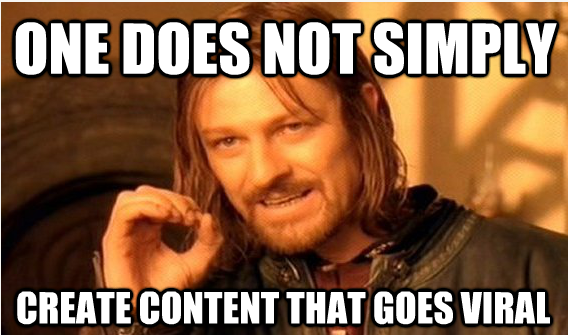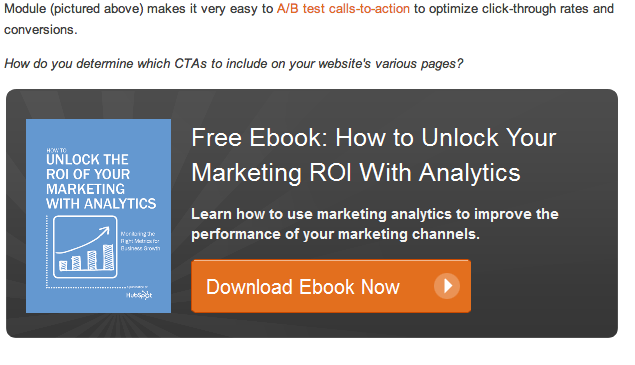
Do you want to get more leads from your blog?
Generating leads from content isn’t just about writing a couple posts and publishing a white paper. There’s actually a science behind it. From the ads you use to generate interest to the words you use in the opening sentence, all of these things can impact the number of leads you’re going to get from content marketing.
So if you are looking for your content to spread and actually be able to convert, review a few of these tips and be sure to bring them to life in your content marketing over the course of the year.
Make Explicit Call to Actions
I find it odd how I still can have a conversation with a marketer and they talk about the importance of site traffic. They talk about how increasing traffic to their clients website is their number one goal and how doing so will lead their client to success. Well, I’m here to pop a bubble.
Traffic alone doesn’t drive leads and it doesn’t drive dollars. You need to be able to convert that traffic once it lands on your site through call to actions strategically placed throughout your site. Whether it’s at the end of each blog post as seen here on Hubspot:
Or it’s through a simple plugin install like the HelloBar which places a call to action on key pages driving conversion. Your call to actions can be anywhere and can be the key to achieving measurable success for your business or your clients. Whether they’re embedded within your posts as text links or on a separate landing page all together.
Optimize Your Title for SEO & Consumers
Many people overlook the importance of writing a captivating and click-worthy title for your blog posts. Writing good blog titles are one of the most important aspects of search engine optimization and content marketing. It’s important that when you’re writing your keyword you use a keyword phrase you’re targeting in the blog post while also writing one that is captivating enough to capture your target audiences attention and make them click.
Whenever I talk about titles for blog posts I always talk about an acronym called “CAB”. Using this system I’ve helped a wide variety of clients craft blog posts worth sharing and worth clicking. As you develop your blog titles, keep these three things in mind:
Blog Titles – The CAB System
1. Clear Titles: Avoid vague language by any means necessary. It’s important that people can read your title and immediately know what it is that you’ll be offering them if they decide to click the link. You should read your title and ask yourself “If I didn’t just write this post, would I really know what exactly I’m going to learn from reading this post”. If you can’t answer that question with a yes, you need to re-work your title. An example of a clear title is my post: 5 Ways to use the Internet for Personal Development, it doesn’t get much clearer than that.
2. Actionable Titles: I’ve learned to understand the role of creating actionable content instead of passive content over the last two years of work with clients and colleagues. What I’ve realized is that your readers, clients and visitors want to typically learn something from reading your content. When developing a title, use it to demonstrate that your content will give them action-oriented takeaways by injecting verbs and powerful action words throughout. The ability to create actionable content will also ensure that readers consistently believe that your blog posts are must-reads. Notice how actionable the title of this post is, indicating that you’ll learn how to triple your content marketing ROI.
3. Brief Message: If your blog post has a title that is longer than 12 words, try again. Simple, concise yet descriptive blog posts are always more successful than overly descriptive long, drawn-out titles, which can often sound complicated and lose a readers attention. In this case, size does matter and the shorter the better.
Use H1, H2, H3 (Header Tags) in your Content
I’m a fan of headers throughout content for a few reason. Reason number one is that headers can enhance and improve a readers experience when they consume your content. It helps visually break up a longer blog post and make the experience more palatable. Some readers simply want to scan through a piece of content, get the key points and leave.
Second, headers are awesome for Search Engine Optimization. Header tags are an element within each of your blog posts that search engines will crawl and use for keyword inclusion if it seems qualified and legit. See the different fonts on this blog post? Those are written with header tags.
Inject your Content with Stats & Research
After I write a blog post I like to scan it for opportunities to link back to compelling stats to support any claims that I’ve made.If you haven’t already been injecting your content with stats, consider starting a running list of research resources to which you can refer to on a regular basis to save the time for going out and searching for stats from scratch.
Use Sharebar to Increase Sharability
If you give the ability to let your readers choose which social media site they wish to share your blog posts with, they will be more likely to share your content. Some people may not want to have a lot of different social media plugins on their site but I strongly recommend Sharebar. It’s the plugin that follows you when you click a blog post on my site and follows you asking to share, tweet, like or post to Linkedin. This helps get your content shared on social media to people you wouldn’t have otherwise reached, and by extension, drives more traffic.
Finish Content with a Value Exchange
If you write great content, people will expect that you will also share great content. After reading a post that captivates their imagination or gets them thinking, you have a chance to connect with them on another channel to deepen your relationship. At the end of a blog post, simply have a call to action with social subscription buttons or by driving users to your social media channels like Twitter or Facebook.
Conclusion
If you take these items and implement them into your approach to content marketing you should see an increase in the number of visitors to your site who are actually able to be converted. When you publish content, it will get attention and that attention will lead to potential leads.
All I ask is that you continually rinse and repeat these items for every piece of content you develop. These are methods that I’ve helped clients implement and watch them see results go through the roof. Mark my word, within a few months of doing the items highlighted above, you should see a significant increase in the number of visitors to your site who are actually becoming leads.
Are there any other ways you can be more effective with content marketing to ensure results?

